When I wrote the script for An American Werewolf in London(written in 1969, produced in 1981), I envisioned the metamorphosis from man to beast as a violent and painful one. The character of David Kessler (David Naughton) would transform from a two-legged human into a four-legged “hound from hell.” I also specified that the sequence take place without cutaways and in bright light. The gifted make-up artist Rick Baker accomplished this with an elaborate combination of make-up, foam appliances, and what he called “change-o” body parts. These were elaborate puppet reproductions of parts of Naughton’s body (including his torso, hands, feet, head, and face) that could actually stretch and transform into the wolf monster in real time on camera. This sequence took five days to shoot. I ended up using one cutaway: of a toy Mickey Mouse silently watching. Rick won the first of his many Academy Awards for his groundbreaking work.
In Joe Dante’s terrific The Howling[1981], the character of Eddie Quist (Robert Picardo) positively relishes his lycanthropy and gleefully transforms in front of a terrified Terry Fisher (Belinda Belaski). In this movie, werewolves seem to transform either at will or from sexual arousal. TV anchorwoman Karen White (Dee Wallace-Stone) has a particularly disturbing encounter with Quist in a porno booth at a sex shop while a film of a rape is being projected. Karen White eventually turns into a sort of fluffy, poodle-dog-werewolf during a live television news broadcast!
As in the Underworldpictures, the popular Twilightmovies also chronicle the conflict between a race of vampires and werewolves. Also like the Underworldmovies, the Twilightseries uses computer-generated imagery to accomplish not only the man-into-wolf transformations, but also the monsters themselves. In Eclipse[David Slade, 2010] the werewolves tend to all be very buff, shirtless young men who transform into wolves by leaping into the air.
Hogwarts’ unfortunate Defense Against the Dark Arts teacher Professor Lupin (David Thewlis), introduced in Harry Potter and the Prisoner of Azkaban[Alfonso Cuarón, 2004] is another werewolf who uses CGI to “morph,” while Jack Nicholson in Wolf[Mike Nichols, 1994] uses a far more subtle, traditional make-up by Rick Baker.
Since the werewolf is here to stay, I suggest taking the excellent advice given by the customers of The Slaughtered Lamb pub in An American Werewolf in London: “Stay on the road. Beware the moon.”
Werewolves[ Book Contents]
An American Werewolf in London [John Landis, 1981]
Scotland Yard’s Inspector Villiers (Don McKillop) attacked by the werewolf in Piccadilly Circus.
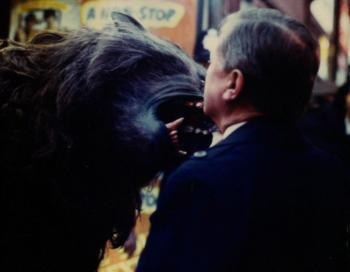
Werewolves[ Book Contents]
Michael Jackson’s Thriller [John Landis, 1983]
Michael Jackson as a teenage werecat “strangling” me on the set of Michael Jackson’s Thriller. Photo by Douglas Kirkland.
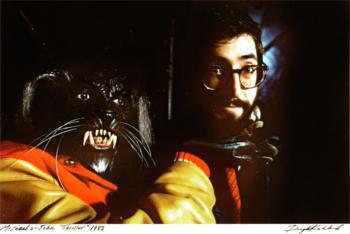
Werewolves[ Book Contents]
The Werewolf [Lucas Cranach the Elder, -]
This woodcut by the German Renaissance painter, engraver, and printmaker shows a lycanthrope attacking a village.
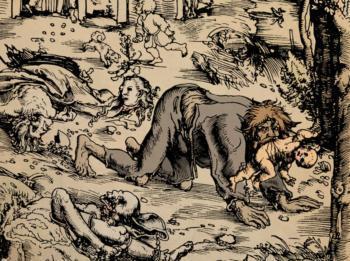
Werewolves[ Book Contents]
Little Red Riding Hood [Charles Perrault, 17th century]
German postcard illustration [c. 1900]. Charles Perrault wrote the first account of the French folk tale in the 17th century. In Perrault’s telling, Little Red Riding Hood ends up as a tasty meal for the devious Wolf.
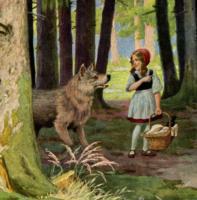
Werewolves[ Book Contents]
The Wolf Man [George Waggner, 1941]
This ad for Universal Studios’ newest monster stresses the transformation “from Man to Beast” as a major marketing strategy.
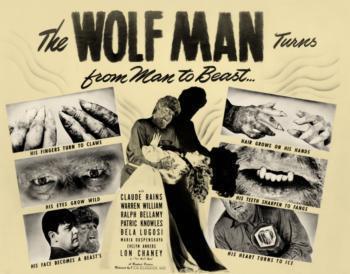
Werewolves[ Book Contents]
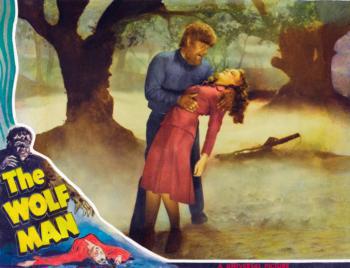
Lon Chaney, Jr. as the tragic Wolf Man of the title holding the lovely Evelyn Ankers in his arms. I’ve never understood why the werewolf that bit him (the Gypsy Bela, played by Béla Lugosi) was a proper, four-footed wolf and Talbot became a two-footed wolf man.
Werewolves[ Book Contents]
Cat People [Jacques Tourneur, 1942]
French actress Simone Simon stars as Irena Dubrovna in this intelligent thriller from the Val Lewton B Picture Unit at RKO Studios. The sequence where a jealous Irena follows her husband’s secretary to her apartment building’s swimming pool is still eerie after all these years.
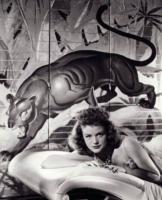
Werewolves[ Book Contents]
Werewolf of London [Stuart Walker, 1935]
Henry Hull refused to wear the make-up Jack Pierce designed for the werewolf, as he felt it hid too much of his face. Pierce and Hull settled on the face pictured here in a highly retouched publicity photo from the original release. Pierce ended up using his first Werewolf of Londondesign on Lon Chaney, Jr. in The Wolf Man.
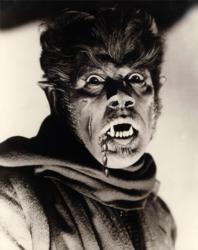
“The werewolf is neither man nor wolf, but a Satanic creature with the worst qualities of both.”
Dr. Yogami (Warner Oland), Werewolf of London
Werewolves[ Book Contents]
The Curse of the Werewolf [Terence Fisher, 1961]
Oliver Reed makes a splendid werewolf in this handsome Hammer film. Roy Ashton, Hammer’s go-to monster maker, did Reed’s werewolf make-up.
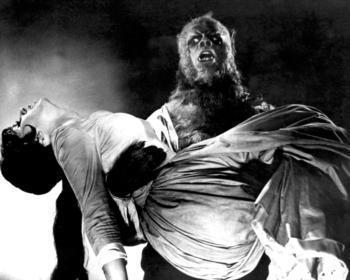
“Their dream of love a nightmare of horror!”
From the trailer for The Curse of the Werewolf
Werewolves[ Book Contents]
Dog Soldiers [Neil Marshall, 2002]
A squad of British soldiers on a training mission in the Scottish Highlands has a nasty encounter with a family of werewolves in Neil Marshall’s exciting, action-packed horror movie.
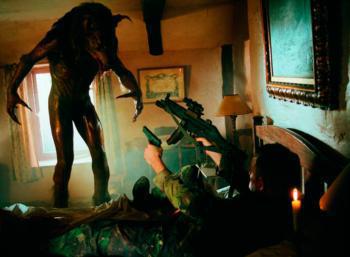
“They were always here. I just unlocked the door.”
Megan (Emma Cleasby), Dog Soldiers
Werewolves[ Book Contents]
How to Make a Monster [Herbert L. Strock, 1958]
Actor Gary Clarke in Michael Landon’s Teenage Werewolf make-up from the earlier film, poses with Gary Conway, the Teenage Monster from I Was a Teenage Frankenstein[Herbert L. Strock, 1957].
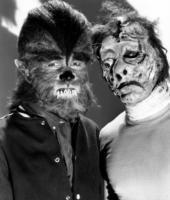
Werewolves[ Book Contents]
Ginger Snaps [John Fawcett, 2000]
A smart take on werewolf mythology and a clever examination of teenage angst and sexuality. Two “goth” sisters, Ginger and Brigitte Fitzgerald (Katharine Isabelle and Emily Perkins) meet the Beast of Bailey Woods and find out that it’s a lycanthrope.
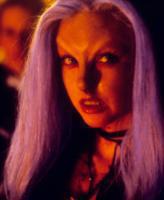
Werewolves[ Book Contents]
The Howling [Joe Dante, 1981]